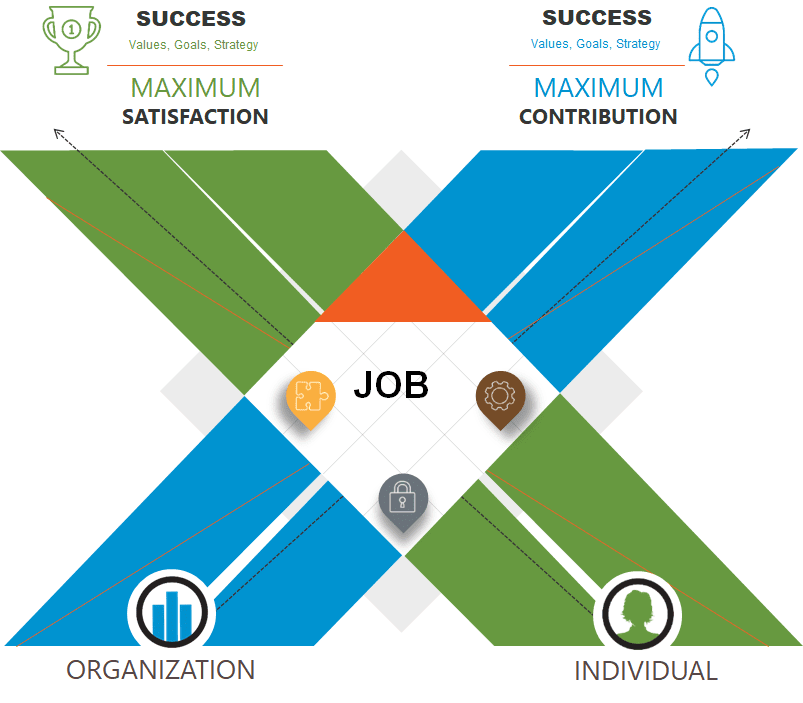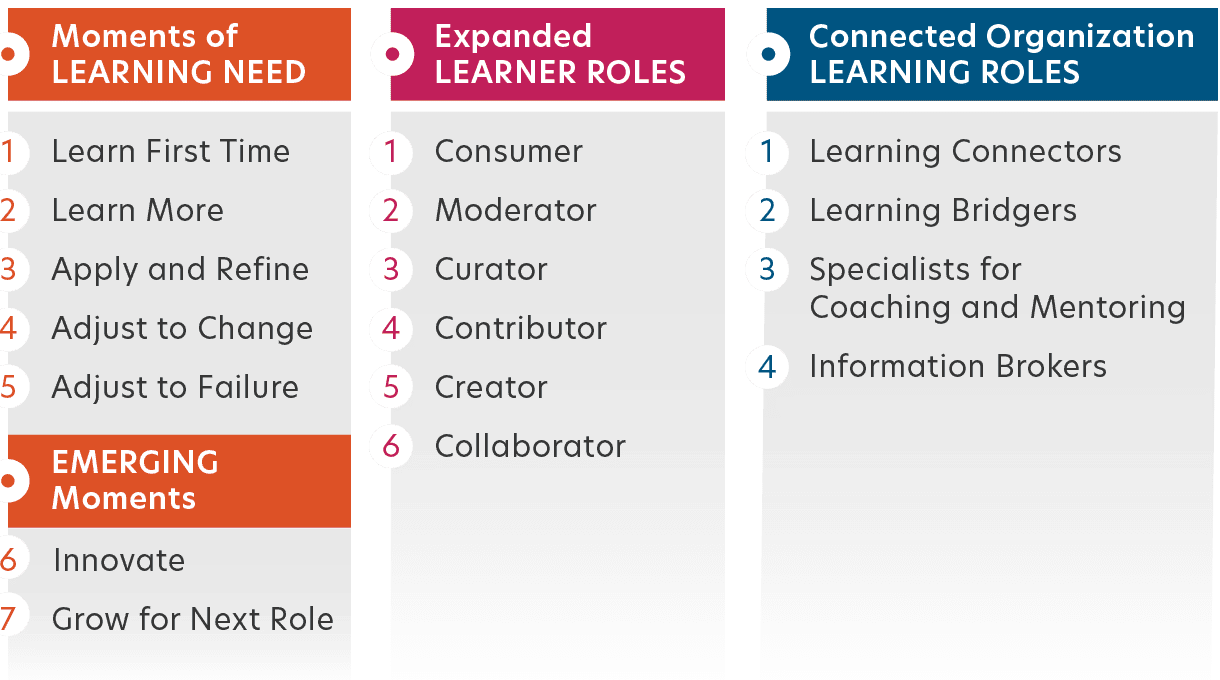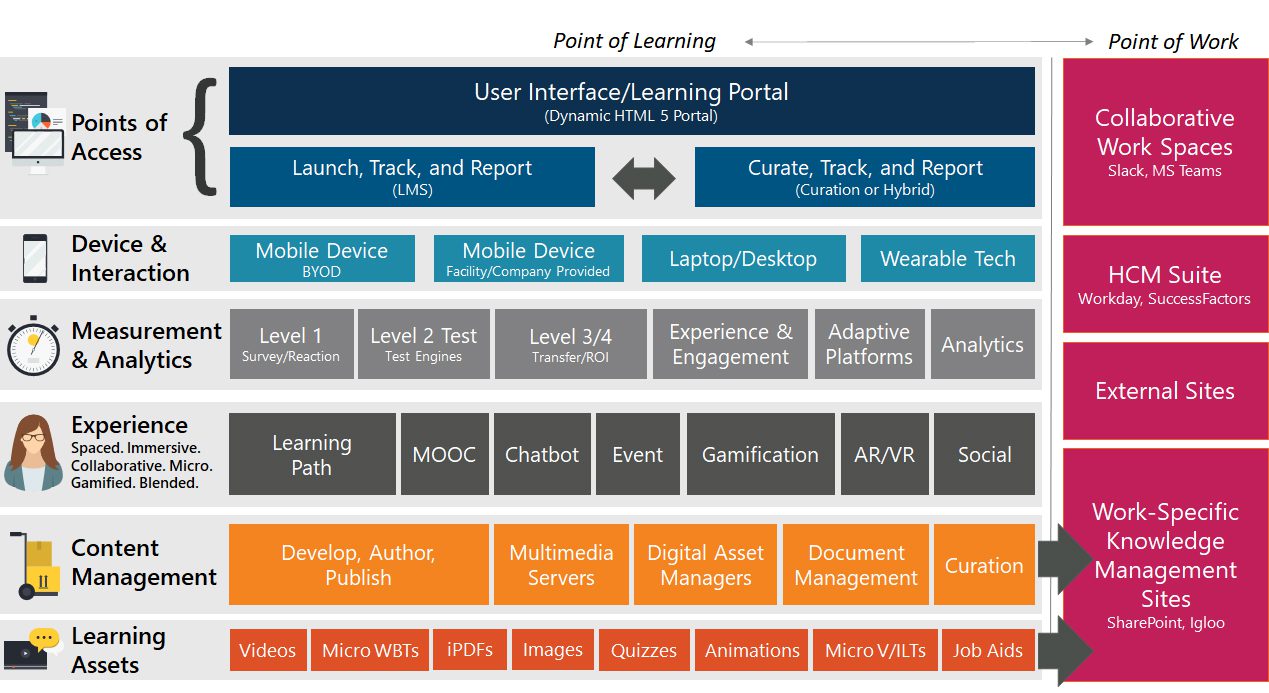A hybrid workforce is defined by a mix of employees, some of whom work in an office, some of whom work away from the office, and all with the ability to move back and forth between both environments. While some employees have worked remotely for decades, the recent boom in virtual work necessitates the creation of a larger and scaled infrastructure to support it.
The explosion of hybrid work has moved what was once an employee accommodation to a purposeful strategic company-wide approach. This resulted from the need to keep employees safe, reduce costs, and meet increasing employee demands for flexibility. There are implications for both employees and organizations. In order to structure a productive and satisfying work experience, both need to take responsibility for creating a hybrid scenario that works.
Addressing the Challenges of a Hybrid Workforce with Four Critical Strategies
A hybrid workforce has challenges—real and perceived. There are concerns about how employees will continue to collaborate and innovate if they are not together. There is a heightened awareness of digital fatigue, and personal wellbeing is increasingly being highlighted. Still, others wonder if productivity and effectiveness can be sustained. Business leaders worry that the organization’s culture will suffer if employees are physically scattered.
Going forward, new approaches need to be imagined related to career development and learning while simultaneously ensuring there is equitable treatment across all dimensions of the organization.
There are four critical areas that affect organizational performance that need to be addressed:
- Sustainable Organization Design and Change Management
- Intentional Leadership Mindsets and Skillsets
- Supportive Technology
- A Connected Learning Organization

Unfortunately, it’s not as simple as employees deciding where they will work. Successful and sustainable hybrid workforce models are those where leaders take a holistic approach and build sustainability into their hybrid workforce model.
Business leaders can accomplish this by setting a clear strategy, aligning organizational capabilities to support the strategy, and enabling people to deliver.
Setting a Clear Strategy Across Your Hybrid Workforce
While some teams are working through the questions of hybrid individually, business leaders need to look across the organization and ask more targeted questions. For example: What organizational capabilities are needed to function globally and regionally in this new hybrid work model? How does the organizational structure need to shift to align and organize around those capabilities? How do we get the right people, and how do we support them from a training and leadership perspective? What are we measuring to determine the organization is shifting successfully?
These questions are important, but start by reviewing the current strategic priorities. Determine if there are critical impacts to these priorities that need to be addressed. The strategic priorities are designed to help the organization grow and compete in the market. They establish the roadmap by which an organization can extend and protect its core, deliver managed growth, and capitalize on new growth areas. As such, it’s not enough to take the existing strategy and layer hybrid work models on top of it.
As it relates to the strategy, organizations need to evaluate potential effects on the strategic priorities and determine how best to address them. Organizations often see effects in the form of performance failures. These failures can come from an inability to make decisions rapidly, to react to market changes effectively, or perhaps allocate resources appropriately.
Once the current strategy has been reviewed and redefined, leaders must able to confirm that capabilities are aligned to deliver on this strategy.
Aligning Organizational Capabilities in a Hybrid Workforce
Organizational capabilities are assets or characteristics that, while often intangible, are critical for success. Collective skills, expertise, and alignment of people across an organization often come to mind when discussing organizational capabilities. Other examples that affect the strategy include cross-functional collaboration, unique technology, decision-making agility, talent management, and readiness for change.
While developing strategy is a strength of many organizational leaders, it is often done without thorough consideration of the capabilities or characteristics of the organization and the people in it. Additionally, as the strategy shifts, capabilities needed to support that strategy may also shift and must be considered.
As the way work gets done changes, we must reexamine the existing workforce capabilities and expectations. New systems may replace existing teams. New agile collaboration models may require a shift in structure. As the work processes and roles are shifted, jobs must be reexamined for fit within the new framework.
Enabling People to Deliver
As the workplace continues its transition into a hybrid workforce model, organizations must prepare and enable people to deliver in that environment. Although this is primarily an employee-driven change, not all employees are excited about it. For many, it will create new challenges with a lack of social interaction, struggle with separating work from home, and difficulty fully engaging with their work. For those who prefer a traditional face-to-face set-up, the landscape of the workplace and society as a whole may have shifted such that it is actually challenging NOT to engage in this. Regardless of opinions surrounding the new nature of work, people must be enabled to flourish.
Culture plays a significant role in enabling people to deliver in the new hybrid work environment. Similarly, how well people are enabled influences culture. Establishing expectations without the proper development, systems, or change management to support the delivery of these expectations will damage the morale, engagement, and productivity of your workforce. Leadership must fully understand and support the shift in the approach, the hybrid model must be fully defined and understood by all employees, and systems and policies must be set up to support the new working model; otherwise, we are setting up employees to fail. We are asking employees to engage in new processes, a new way of working together, and new expectations. This is a significant shift, and effective enablement of the workforce begins with change management.
Change Management Plays a Huge Role in Transitioning to a Hybrid Workforce
Although there tends to be a natural resistance to change within organizations, in the case of hybrid models, employees are driving the change. How will leaders help and guide employees through the change while simultaneously navigating their own struggles and challenges? Key components of change must focus on leadership adoption of the change and developing leaders to support employees through it.
As organizations try to define their own models, any combination of work can be considered hybrid:
- Asynchronous
- Differently located
- Choice in when and where to work
- Specified in- versus out-of-office arrangements
- Core working hours
A “hybrid work model” does not have a single definition. As organizations develop their strategy, structure, and processes, they must consider the hybrid arrangement that best aligns with and supports their strategy. Employees and leaders must have the same understanding of expectations in order for the model to work.
Finally, for effective change, we must ensure systems are designed to support the new way of working. Technical systems will support how the work gets done, but performance management, compensation, and learning systems are equally critical:
- How are employees incentivized?
- Is there a loop for gaining and sharing feedback?
- Are systems in place to support asynchronous work schedules in addition to differently located work?
Every decision has both intended and unintended consequences. Change practitioners need to develop an agile change management model that progressively defines the change and adjusts as the environment adjusts.

While organizations will establish strategy and address organizational design issues, implementation of those strategies rests on the shoulders of the leaders. As their roles change into that of a “hybrid leader,” what do people managers need to do differently, and where should they focus?
Luckily, the cornerstones of good leadership don’t actually change in a hybrid model.
Leaders of hybrid work teams need to focus on what they’ve always focused on: contribution and satisfaction. They need to help their teams perform, and they need to understand what motivates employees. The context has changed, but the fundamental need to focus on these two things exists regardless of location.

While organizations and employees have proven they can be productive in a virtual environment, it is the satisfaction side of the equation that may be suffering. Organizations, and their people, have proven they can “get it done.” They’ve been productive, but at what cost? Wellbeing, a priority for many employees, has suffered. Digital fatigue and an always-connect-to-work scenario threatens work-life balance. Career development has been neglected. Employees have survived, but how can leaders refocus on helping them thrive. Hybrid leaders need to redouble their efforts on employee satisfaction. Some ways they can do this are to:
- Understand what’s important to employees. More than ever, engage the entire person.
- Continue to talk about career development regardless of location.
- Be mindful of fatigue and burnout.
- Know, above all, that this is not a one-size-fits-all approach.
Leader Mindsets and Skillsets to Lead Hybrid Teams
Leaders need to hone new mindsets and apply the same skillsets in a new context.
When leading a hybrid workforce, leaders need to think digital and virtual first. In scenarios from onboarding to collaborative meetings, leaders need to assume that at least some of their team will be participating virtually to a degree. Digital and virtual needs should be the starting point.
A hybrid leader needs to think from the perspective of four key leadership mindsets—agile, inclusive, enterprise, and growth. They need to apply these mindsets to this new context.
Re-Enabling High Performance Teams in a Hybrid Work Model
While leaders need to understand the lived reality of each member of their team, they also need to be mindful of how to drive team performance as a whole. The same critical elements of an in-person team create a strong, high-performing team. What’s different is the context in which these elements are applied and, as a result, the nuances of application.
Build Trust: Building trust is about creating an environment where team members feel supported, including having a sense of psychological safety. Hybrid leaders can build trust by expressing empathy, ensuring equitable treatment, and maintaining clear and transparent communication.
Create Connection: Creating connection is about ensuring teams have open communication and opportunities to share and learn. Leaders need to demonstrate greater emotional intelligence and stay attuned to the nuance of communication, including tone, body language, and frequency. They might need to schedule intentional check-ins to make up for the occasional, in-person interactions that have been lost. They can look for ways to foster connection by finding opportunities for the team to connect personally, creating rituals, and celebrating accomplishments.
Seek Alignment: Leaders need to align to goals regularly with all members of the team, set clear expectations about in-office moments, and enhance clarity and transparency around the work of the team. This includes how decisions will get made and how members will hold each other accountable. They need to listen actively and increase coaching, so they can support greater self-reliance among team members.
Drive Results: Finally, leaders need to set clear goals for what success looks like, provide feedback, and proactively ask for feedback themselves. Critical to driving results is keeping regular one-on-ones, or considering the creation of “office” hours. A hyper-sensitivity to running effective meetings is the last, and one of the most critical, elements of driving hybrid workplace success. Establish a clear agenda and meeting rules, including participation expectations. Technology can play a role in supporting these efforts, if employed appropriately.

Media is filled with stories of “The Great American Resignation.” While HR technology plays a supporting role in enabling employee-based business processes, if that technology is not “fit for purpose” to meet the needs of the organization and the employees, it can be a major factor in determining if the hybrid model is successful. How and when technology is used plays a critical role in helping to drive the organization’s strategy and improving employee satisfaction and retention.
In the shift to a hybrid workforce, organizations need to reassess how they’re using technology and analyze how well it is meeting their needs.
Employee Expectations
Nearly everyone above the age of 12 has a cell phone with easily available information, and employees expect a similar level of sophistication while working. Employees need the ability to track where they are and where they’re headed in their careers, from their skills to their opportunities, and be able to complete day-to-day tasks in their current role. The technology an organization uses needs to be an integrated mechanism to accomplish all aspects of an employee’s experience daily and long-term.
Information Demand for Agile Decision-Making
There is going to be a much greater need from leadership for information on-demand regarding capabilities, skillsets, gaps, how to close gaps, and how to execute on strategy and vision for the organization. Executive leadership will expect to be able to access this information and understand it clearly.
While leaders have the same employees, when they can’t strictly see them regularly, it gets more difficult to look collectively at the group and understand their capabilities. It’s a problem whether people are in the office or working remotely.
During the shift to a hybrid workforce, organizations need to provide the technology for leaders to map employee skill levels, gaps, and learning demand effectively.
Ultimately, if technology in not intuitive, responsive, collaborative, and supportive of flexible business processes, employee satisfaction and an organization’s ability to execute effectively will suffer.

Finally, if organizations and their people are going to move from surviving to thriving in a virtual environment, establishing opportunities to learn and grow are critical; however, these opportunities need to move beyond simply converting training to a virtual instructor-led format. A connected learning organization needs to meet employees wherever they are, regardless of location. It also needs to take advantage of all that technology has to offer to make that happen.
In a previous article on virtual training, we discussed how to establish a strong virtual training practice. Part of that included developing a survive, revive, and thrive roadmap. Most organizations found themselves in the first step of this roadmap, quickly converting content to virtual instructor-led training (VILT) and ramping up virtual delivery. But as hybrid workforce models are becoming the preferred future, learning teams are upgrading, rebuilding, or need to rebuild their learning strategies and structures.
The thrive concept in the roadmap is a process to develop learning beyond simply converting training you have already to virtual formats. It is structuring learning in new ways that can support employees’ preferred learning habits with the goal to build skills collaboratively over time.
An example of a learning program designed for multiple needs over time might look like the following timeline:

The New Roles for the Connected Learning Organization
Hiring for predefined roles isn’t necessarily the best approach anymore. Employees are learning multiple skillsets and are looking for what their future role might be. Learners themselves are becoming contributors.
The following graph compares the moments of learning need with how learning roles are changing:

Rethinking how employees access, interact with, and contribute to learning across an organization is a core principle of designing learning and performance support programs. Organizations need to build these mindsets into learning roles to create a truly connected and agile workforce along with the programs to support them.
The Work-Learning Ecosystem
Lastly, learning teams need to put the tools, learning technologies, and structures in place to enable learning delivery and measurement across an organization. Here is a sample map we use often to illustrate this point.

The main point of this is to set up a system with the right technologies to meet employees at the moment of learning need.
The Hybrid Workforce Is Redefining How Business Is Done… for the Better
The impact of the hybrid workforce explosion will reverberate for many years. Organizations that embrace hybrid and plan thoughtfully for it will be ahead of the game in terms of long-term viability. They will continue to be successful in achieving their goals and fostering an environment where people want to come to work each day—even when “coming to work” means settling into a favorite dining room chair. By focusing on strategy, leadership, technology, and learning, organizations can make sure that chair is firmly supported.
About the Authors
Leah Clark is the Senior Director for Leadership with more than 27 years of experience in leadership, strategy, marketing, and product development. She works with organizations to bring creative solutions to leadership and engagement challenges at all levels. She is an author, researcher, and speaker at global events.
Chris Davis is the Senior Director of Business Consulting. He has over 20 years of experience delivering consulting and organization design solutions to Fortune 500 companies and his work has regularly helped connect strategy to execution. Prior to joining GP Strategies, he was a Naval Officer leading teams of a nuclear submarine.
Matt Donovan is the Chief Learning and Innovation Officer and is a recognized name in learning, bringing more than 25 years of experience crafting learner-centric solutions and leading high-impact development teams. He has a background in instructional design and often leads workshops, speaks at global events, and has won many industry awards, including being named one of Training Magazine’s Top 10 International Trainers under 40.
Cheryl Jackson, PhD is the Organization Design and Change Practice Lead. She is a highly experienced consultant, working with organizations to improve operations through assessment, job design, learning and development, performance management, and organization design. She is a regularly published author, speaker, and lecturer at Texas A&M University. Cheryl is also the Founder of The Psycho Mom and Co-Founder of The CornHer Office, a community to provide resources for women in the workplace.
John Plusquellec is the Vice President of Human Capital Technologies and has been active in the HR Technology consulting business for over 20 years. He and his organization specialize in supporting client’s HR transformations, from implementing new technologies to redesigning business processes across all industries to improve business performance.
